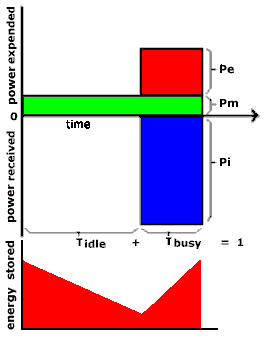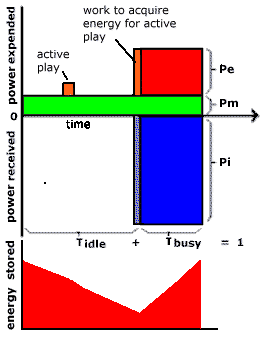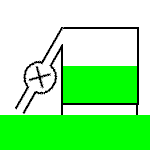
All science is either physics or stamp collecting.
Ernest Rutherford
Physicists have been curiously reluctant to produce a physical model of life. It is not possible to flick through a physics textbook and find a chapter on Life Processes appended to those concerned with the Kinetic Theory of matter, or Thermodynamics, or Newton's laws of motion.
The omission may be purely an accident of history, that the study of life became, very early on, the province of naturalists, biologists, ecologists, and more recently geneticists. Physicists, with enough on their hands already, were perhaps content to leave the matter in their hands.
Yet one strange result is that, despite constant complaints that the life sciences are reductionist and mechanistic, there exists no mechanistic description of life. There isn't even agreement as to what constitutes Life. Thus the Idle Life model will not be found in any physics textbook. Although its description of life adopts the terminology of physics, it is no part of the formal edifice of physics.
The Idle Life model attempts to mirror the behaviour of real life. It has a metabolism that acquires and expends and stores energy. It can grow and reproduce. It can die. Given such a model of life, it becomes possible to construct populations of theoretical idle lifeforms, that correspond to plants, grazers, predators, and simulate variation and natural selection, and to do so knowing that the unfolding scene is not physically implausible. Without some sort of model, such theoretical explorations are impossible.
The Idle Life model is a simple, idealised model of life. There are probably no real living creatures which are so simple. But a great many real living creatures appear to behave in roughly the manner it describes. And that is enough to begin with. Idle Theory is only concerned with the broadest behaviour of life, not with particular details.
Life.
In Idle Theory, life is treated in terms of energy. In Idle Theory, living creatures are understood to be constantly decaying and constantly repairing themselves. This is physical work. And in order to repair themselves they have to extract fuel and raw materials from their surrounding environment. This also is physical work.
In physical discussions of life, living creatures are quite ordinarily described as having a power income and a power expenditure . But these incomes and expenditures are usually implicitly continuous. In Idle Theory power income and expenditure are discontinuous or intermittent.
|
Two assumptions underlie the Idle Life model.
- The creatures are assumed to work continuously at maintaining or replacing their constituent components. This work is regarded as a continual background activity, the intensity of which depends upon the ease or severity of the environment in which these components exist - temperature, salinity, acidity, etc.
- The creatures work intermittently to acquire from their
environment the energy needed to power their maintenance work.
One argument for such intermittency lies in a the intermittent availability of energy in the environment: plants can only acquire solar energy during daylight hours, and many animals require daylight by which to find food.
Another argument is that even if energy is continuously available in the environment, the creatures are likely to be able to meet their energy requirements in a relatively short time.
Included in the assumption of intermittent work is an assumption that the creatures have a constant sustainable work rate. This is a simplification. But it reflects the important truth that, although creatures may be able to increase their work rates by an order of magnitude, they cannot sustain such work rates for long.
A further argument for intermittency is that if the creatures simply worked continuously, at whatever rate required, to acquire energy to power self-maintenance, they would have no need to store energy. But in the natural world, creatures typically maintain substantial energy stores, in the form of sugars, fats, starches.
 Given these assumptions, it is possible to write some simple equations:
Given these assumptions, it is possible to write some simple equations:
Assume some lifeform continuously works at a rate Pm repairing itself.
Assume that it is able to work at a rate Pe to acquire energy to power repair.
When it works to acquire energy, it acquires a power income of Pi. The power income, Pi, that the creature gets for its expenditures is dependent on the energy density of its environent. In an energy-rich environment, Pi will be larger than in an energy-poor environment.
At equilibrium, it alternates between being busy acquiring energy for Tbusy time, and being idle for Tidle time, and its energy store level cycles between a maximum and a minimum.
At equilibrium, over unit time period, energy expended = energy received.
Energy received = Pi.Tbusy
Energy expended = Pe.Tbusy+ Pm
So Pi.T busy = Pe.Tbusy+ Pm
and T busy = Pm / (Pi - Pe)
| and I = 1 - ( Pm / (Pi - Pe)) | ( 1 ) |
A variant of this equation is:
| I = 1 - ( Pm / Pe(G - 1)) | ( 2 ) |
Given these assumptions, the Idleness of a lfeform is independent of the length of the cycle. It makes no difference whether it maintains its store at a high mean level, or allows its store to cycle more slowly from a high level to a low level.
The power consumption of this lifeform over the cycle is given by:
| (1 - I).Pi | ( 3 ) |
Idle time need not be devoted to inactivity. A life form can work during idle time to acquire an energy surplus. The power surplus or work capacity of the life form is:
| I.(Pi - Pe) | ( 4 ) |
Where a creature is growing in size, or reproducing, the extra power expenditure for reproduction, Pr is added to maintenance power expenditure, and (1) becomes
| I = 1 - ((Pm + Pr) / (Pi - Pe)) | ( 5 ) |
Living creatures operate in the range 0 to 1 idleness. 0 (0r 0%) idleness means working all the time. 1 (or 100%) idleness means they are idle all the time. In practice, 100% or perfect idleness cannot be achieved, because no combination of non-zero values of Pm, Pr, Pe, and Pi can produce I = 1. Zero idleness, by contrast can be very easily achieved.
Inert matter might be construed as perfectly idle, since (Pm, (Pr and (Pe are zero, and I = 1.
Death.
The creatures die when their energy stores empty, and no further maintenance work or energy-acquisition work can be done, and the unmaintained creatures disintegrate.
Taking Pm and Pe as constant, then
as Pi rises, idleness approaches 1. In this circumstance
a creature spends next to no time meeting its maintenance energy needs.
But as Pi falls, idleness falls, and continues to fall
until idleness reaches zero. At this point, a creature is spending
all its time working to meet its maintenance energy needs.
If Pi falls further, the creature becomes unable to
meet its maintenance energy needs, because it can work no harder.
In this circumstance, it loses energy, and its energy store empties.
 Thus zero idleness (I = 0)
is the threshold of death for any lifeform.
In Idle Theory, reaching zero idleness is therefore usually taken to
entail death, even though there will be an interval while energy
stores are finally depleted.
Thus zero idleness (I = 0)
is the threshold of death for any lifeform.
In Idle Theory, reaching zero idleness is therefore usually taken to
entail death, even though there will be an interval while energy
stores are finally depleted.
All solutions of the equation I = 1 - ( Pm / (Pi - Pe)) with values greater than zero and less than 1 correspond to life. All other values (I < 0, I > 1) correspond to death. In practice, these absurd values convert to zero idleness.
Reaching zero idleness is the only way that any life form in Idle Theory ever dies.
Death by starvation results when the power income, Pi, falls because there is less energy available in the environment, and idleness is reduced to zero.
Death by disease entails increasing maintenance power, Pm, to include feeding parasitic bacteria, which results in idleness falling to zero.
Accidental damage may result in the stored energy rapidly being lost - effectively increasing Pm -, or by disabling the lifeform so that it is able to do less work to get food - reducing Pe -. Again, if the damage is sufficient, idleness may fall to zero.
Old age entails an increasing inability to work to acquire food - Pe steadily falls -. At some point, idleness reaches zero.
In fact, any creature which is continuously busy, yet still losing energy, is likely to stop working and remain idle while losing energy.
Reproduction is regarded as a special case of self-maintenance. Living creatures are continually repairing and replacing their tissues, and the ability to do this implies an ability to assemble entire copies of themselves. If living creatures slightly overmaintain themselves rather than undermaintain themselves, the excess energy they acquire by so doing may be used to construct such copies.

|
There is no particular reason - apart from strict adherence to a least action principle - why any creature should remain completely inactive during idle time. It may engage in any activity, as long as it acquires sufficient energy to power that activity. The creature simply needs to work longer to acquire energy to power idle time play activities. Although this results in the creature being physically more active, it doesn't change underlying idleness, assuming idle time play activities are optional. |
Throughout the Idle Theory website, a rather broader conception of Idleness is employed than simply the fraction of time not spent finding and consuming food. Humans, in particular, are regarded as having to busy themselves in a variety of necessary tasks of one sort or other - where necessary means needed for survival. In cold climates it is necessary, on pain of death or discomfort, for humans to act to keep themselves warm by staying active, wearing clothes, lighting fires, etc. There may well be other necessary activities. Idle Life 2


